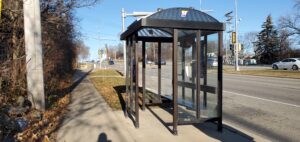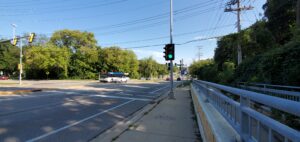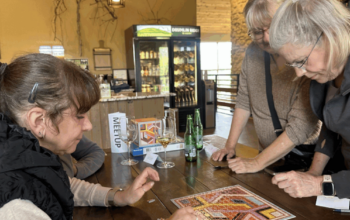For Madison residents, more investments in public transit are the top priority
Markeisha Jackson’s commute to work means she has to take three different buses on a cold winter evening.
“I don’t drive. I don’t own a car,” Jackson said as she waited at Madison Metro’s West Transfer Point for the third bus ride in her journey. Meanwhile, dozens of riders brushed shoulders as they exited buses.
The recently signed Infrastructure Investment and Jobs Act introduces an opportunity to rethink the structure of America’s cities. But most of the money in the infrastructure bill is designated for highway projects, even though nearly 1.2 million Wisconsinites do not drive, roughly a fifth of the population.
“As we continue to fund more highway development… that is really a boon to suburban development, car-centric infrastructure, which has predominantly benefitted white suburban people in Wisconsin at the expense of everybody else,” said Gregg May, transportation policy director for 1000 Friends of Wisconsin. The organization works to raise awareness about the connections between land use, transportation and the environment.

“It doesn’t work for anybody that chooses not to drive,” May said. “We have almost no state funding for walking and biking. We fund transit 10% less than we did in 2006 when adjusted for inflation and it’s created a system that is really inequitable.”
Karen James, another Metro Transit rider waiting in a wind shelter on the transfer point platform, said the availability of Madison’s transit system allowed her to retire a few years early. She now utilizes the bus system to do most of her errands and shopping, because it is affordable.
“I find that at $32.50, the senior bus pass is the best bargain in town,” she said. “For that money, I can go anywhere in Madison, essentially. There’s very few places the buses don’t go.”
For others like Felton Lake, standing on the platform with his bike gently leaning in his hands, taking the bus is also a financial choice.
“Personally, it’s cheaper than trying to bring a car; don’t have to pay for gas, don’t have insurance or registration on a second vehicle, don’t have to pay for parking, [and the] company provides a bus pass for me,” Lake said.
An analysis performed by Move.org found the average annual cost of owning a vehicle in Wisconsin was $4,668 in 2021. This estimate is based on cost of fuel, average miles driven, insurance and repair costs, and fees.
The City of Madison has several initiatives to rethink its approach to streets, including Vision Zero, aiming for zero traffic deaths, a bus rapid transit line, which is similar to a streetcar and some ways to rethink streets for usage by more than just cars. Most federal transportation money, such as the funds provided by the recently signed infrastructure bills, goes through state agencies.
“[The city is] really hamstrung in how they can fund things,” May said. “I think that they’re doing the best that they can given the really constraining environment that they live in, when it comes, especially, to transit.”
James reflected on the cultural changes in America during the latter half of the 20th century as she sat in an uninsulated structure designed to discourage loiterers on a cold night.
“Part of the thing that brought automobiles to the fore, it wasn’t so much that people could go bigger distances, it was partially that you could do it alone, you could do it on your own,” James said. “Community cooperation as a basis for everybody staying alive really kinda ended after WWII.”
Lake connected investments in transportation with actions the city is taking to relieve homelessness. He said the new shelters’ proximity to a bus line could help people struggling with maintaining employment. The two public service initiatives can work in
tandem.

“Transportation is one of the primary ways people get out of poverty,” May said, citing a Harvard study by Raj Chetty, an economist who focuses on inequality and economic mobility.
“This cost of car ownership is preventing a lot of people from getting jobs and the lack of transit access is harming our economic development,” May said. “There are businesses that want employees that they cannot get.”
Madison Metro’s transfer point system sometimes leaves customers stranded for 30 minutes or more as the bus arrival times do not always match up. Jackson thinks vans could pick up some of the slack in the system.
“[There could be] more transportation vans for people who are employed,” Jackson said while waiting for the bus. “Having to travel far, you have to figure out the estimated time and how you’re going to get there and everything. I am going to be a few minutes late.”
As American society reorients itself following the COVID-19 pandemic, transportation needs and opportunities are being reevaluated to address some deeply-rooted failures in city planning and resource allocation. Madison has already invested in initiatives to reconsider the role of streets in the community, but massive federal investment and a societal shift in work and transit habits could enable a serious transformation of the Madison area’s transportation system.
“There are historic investments in transit and in passenger rail [in the infrastructure bill] which is very exciting but there’s also a historic investment in highway infrastructure,” May said. “Continuing this decades-long investment in highway expansion that has essentially worked to defund transit, walking, and biking, increased transportation carbon emissions in the state, [and] that has not worked for anyone that doesn’t drive; that’s a deeply inequitable system.”





